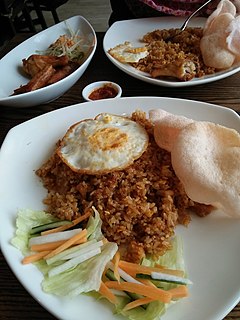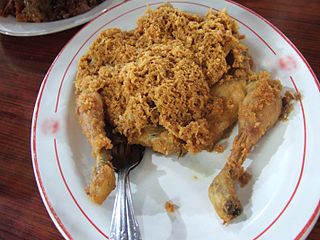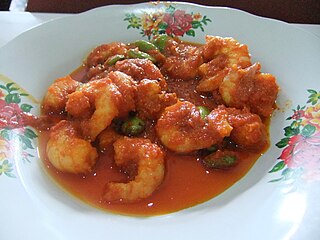

Nasi Padang is a Padang steamed rice served with various choices of pre-cooked dishes originated from Indonesia. It is known across Indonesia as Nasi Padang, after the city of Padang the capital of West Sumatra province. Nasi Padang (Padang-style rice) is a miniature banquet of meats, fish, vegetables, and spicy sambals eaten with plain white rice, it is Sumatra's most famous export and the Minangkabau people's great contribution to Indonesian cuisine. [1]

Padang food or Minang food is the cuisine of the Minangkabau people of West Sumatra, Indonesia. It is among the most popular food in Maritime Southeast Asia. It is known across Indonesia as Masakan Padang after the city of Padang the capital city of West Sumatra province. It is served in restaurants mostly owned by perantauan (migrating) Minangkabau people in Indonesian cities. Padang food is ubiquitous in Indonesian cities and is popular in neighboring Malaysia and Singapore.

Indonesia, officially the Republic of Indonesia, is a country in Southeast Asia, between the Indian and Pacific oceans. It is the world's largest island country, with more than seventeen thousand islands, and at 1,904,569 square kilometres, the 14th largest by land area and 7th in the combined sea and land area. With over 261 million people, it is the world's 4th most populous country as well as the most populous Muslim-majority country. Java, the world's most populous island, is home to more than half of the country's population.

Sambal is a chili sauce or paste typically made from a mixture of a variety of chili peppers with secondary ingredients such as shrimp paste, garlic, ginger, shallot, scallion, palm sugar, and lime juice. Sambal is an Indonesian loan-word of Javanese origin (sambel). It is native to the cuisines of Indonesia, and popular in Malaysia, Sri Lanka, Brunei and Singapore. It has also spread through overseas Indonesian populations to the Netherlands and Suriname.
Contents
A Padang restaurant is usually easily distinguishable with their Rumah Gadang style facade and their typical window display. Nasi Padang window display in front of restaurant usually consists of stages and rows of carefully arranged stacked bowls and plates, constructed and filled with various dishes. A Padang restaurant, especially small-to-medium ones, will also usually bear names in Minang language.

Rumah gadang or rumah bagonjong "house for the Minangkabau people" are the traditional homes of the Minangkabau in West Sumatra, Indonesia. The architecture, construction, internal and external decoration, and the functions of the house reflect the culture and values of the Minangkabau. A rumah gadang serves as a residence, a hall for family meetings, and for ceremonial activities. In the matrilineal Minangkabau society, the rumah gadang is owned by the women of the family who live there; ownership is passed from mother to daughter.
Nasi Padang is a vital part of Indonesian workers' lunch break in urban areas; when Nasi Padang prices in the Greater Jakarta area were raised in 2016, Jakarta municipal civil servants demanded the uang lauk pauk (food allowance, as a component of civil servant's salary) to be raised as well. [2]
The civil service is independent of government and is also composed mainly of career bureaucrats hired on professional merit rather than appointed or elected, whose institutional tenure typically survives transitions of political leadership. A civil servant or public servant is a person employed in the public sector on behalf of a government department or agency. A civil servant or public servant's first priority is to represent the interests of citizens. The extent of civil servants of a state as part of the "civil service" varies from country to country. In the United Kingdom, for instance, only Crown employees are referred to as civil servants whereas county or city employees are not.
Nasi Padang served in Padang restaurants are easily found in various Indonesian cities in Sumatra, Java, Kalimantan, Sulawesi, Nusa Tenggara, and Papua, to neighboring countries Malaysia and Singapore, [3] and Australia because of Minangkabau merantau (migrating) tradition contributed to the dispersion of Minang diaspora outside their traditional homeland in West Sumatra. Based on CNN Travel, Nasi Padang is listed as one of 40 food that Singaporeans cannot live without. [4]

Malaysia is a country in Southeast Asia. The federal constitutional monarchy consists of 13 states and three federal territories, separated by the South China Sea into two similarly sized regions, Peninsular Malaysia and East Malaysia. Peninsular Malaysia shares a land and maritime border with Thailand and maritime borders with Singapore, Vietnam, and Indonesia. East Malaysia shares land and maritime borders with Brunei and Indonesia and a maritime border with the Philippines and Vietnam. Kuala Lumpur is the national capital and largest city while Putrajaya is the seat of the federal government. With a population of over 30 million, Malaysia is the world's 44th most populous country. The southernmost point of continental Eurasia, Tanjung Piai, is in Malaysia. In the tropics, Malaysia is one of 17 megadiverse countries, with large numbers of endemic species.

Singapore, officially the Republic of Singapore, is a city-state in Southeast Asia. The country is situated one degree north of the equator, at the southern tip of the Malay Peninsula, with Indonesia's Riau Islands to the south and Peninsular Malaysia to the north. Singapore's territory consists of one main island along with 62 other islets. Since independence, the sovereign state extensive land reclamation has increased its total size by 23%.

Australia, officially the Commonwealth of Australia, is a sovereign country comprising the mainland of the Australian continent, the island of Tasmania, and numerous smaller islands. It is the largest country in Oceania and the world's sixth-largest country by total area. The neighbouring countries are Papua New Guinea, Indonesia, and East Timor to the north; the Solomon Islands and Vanuatu to the north-east; and New Zealand to the south-east. The population of 26 million is highly urbanised and heavily concentrated on the eastern seaboard. Australia's capital is Canberra, and its largest city is Sydney. The country's other major metropolitan areas are Melbourne, Brisbane, Perth, and Adelaide.



















